+ Open data
Open data
- Basic information
Basic information
| Entry | Database: PDB / ID: 6bbj | ||||||||||||
|---|---|---|---|---|---|---|---|---|---|---|---|---|---|
| Title | Xenopus Tropicalis TRPV4 | ||||||||||||
 Components Components | Transient receptor potential cation channel, subfamily V, member 4 | ||||||||||||
 Keywords Keywords | METAL TRANSPORT / Ion Channel / TRP channel | ||||||||||||
| Function / homology |  Function and homology information Function and homology informationTRP channels / plasma membrane => GO:0005886 / osmosensory signaling pathway / calcium ion import across plasma membrane / monoatomic ion channel activity / actin filament organization / calcium channel activity / cilium Similarity search - Function | ||||||||||||
| Biological species | |||||||||||||
| Method | ELECTRON MICROSCOPY / single particle reconstruction / cryo EM / Resolution: 3.8 Å | ||||||||||||
 Authors Authors | Deng, Z. / Hite, R.K. / Yuan, P. | ||||||||||||
| Funding support |  United States, 3items United States, 3items
| ||||||||||||
 Citation Citation |  Journal: Nat Struct Mol Biol / Year: 2018 Journal: Nat Struct Mol Biol / Year: 2018Title: Cryo-EM and X-ray structures of TRPV4 reveal insight into ion permeation and gating mechanisms. Authors: Zengqin Deng / Navid Paknejad / Grigory Maksaev / Monica Sala-Rabanal / Colin G Nichols / Richard K Hite / Peng Yuan /  Abstract: The transient receptor potential (TRP) channel TRPV4 participates in multiple biological processes, and numerous TRPV4 mutations underlie several distinct and devastating diseases. Here we present ...The transient receptor potential (TRP) channel TRPV4 participates in multiple biological processes, and numerous TRPV4 mutations underlie several distinct and devastating diseases. Here we present the cryo-EM structure of Xenopus tropicalis TRPV4 at 3.8-Å resolution. The ion-conduction pore contains an intracellular gate formed by the inner helices, but lacks any extracellular gate in the selectivity filter, as observed in other TRPV channels. Anomalous X-ray diffraction analyses identify a single ion-binding site in the selectivity filter, thus explaining TRPV4 nonselectivity. Structural comparisons with other TRP channels and distantly related voltage-gated cation channels reveal an unprecedented, unique packing interface between the voltage-sensor-like domain and the pore domain, suggesting distinct gating mechanisms. Moreover, our structure begins to provide mechanistic insights to the large set of pathogenic mutations, offering potential opportunities for drug development. | ||||||||||||
| History |
|
- Structure visualization
Structure visualization
| Movie |
 Movie viewer Movie viewer |
|---|---|
| Structure viewer | Molecule:  Molmil Molmil Jmol/JSmol Jmol/JSmol |
- Downloads & links
Downloads & links
- Download
Download
| PDBx/mmCIF format |  6bbj.cif.gz 6bbj.cif.gz | 439.6 KB | Display |  PDBx/mmCIF format PDBx/mmCIF format |
|---|---|---|---|---|
| PDB format |  pdb6bbj.ent.gz pdb6bbj.ent.gz | 350.8 KB | Display |  PDB format PDB format |
| PDBx/mmJSON format |  6bbj.json.gz 6bbj.json.gz | Tree view |  PDBx/mmJSON format PDBx/mmJSON format | |
| Others |  Other downloads Other downloads |
-Validation report
| Summary document |  6bbj_validation.pdf.gz 6bbj_validation.pdf.gz | 1 MB | Display |  wwPDB validaton report wwPDB validaton report |
|---|---|---|---|---|
| Full document |  6bbj_full_validation.pdf.gz 6bbj_full_validation.pdf.gz | 1 MB | Display | |
| Data in XML |  6bbj_validation.xml.gz 6bbj_validation.xml.gz | 67.6 KB | Display | |
| Data in CIF |  6bbj_validation.cif.gz 6bbj_validation.cif.gz | 102 KB | Display | |
| Arichive directory |  https://data.pdbj.org/pub/pdb/validation_reports/bb/6bbj https://data.pdbj.org/pub/pdb/validation_reports/bb/6bbj ftp://data.pdbj.org/pub/pdb/validation_reports/bb/6bbj ftp://data.pdbj.org/pub/pdb/validation_reports/bb/6bbj | HTTPS FTP |
-Related structure data
| Related structure data |  7075MC  6c8fC  6c8gC  6c8hC M: map data used to model this data C: citing same article ( |
|---|---|
| Similar structure data |
- Links
Links
- Assembly
Assembly
| Deposited unit | 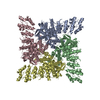
|
|---|---|
| 1 |
|
- Components
Components
| #1: Protein | Mass: 99087.852 Da / Num. of mol.: 4 Source method: isolated from a genetically manipulated source Source: (gene. exp.) Gene: trpv4 / Production host:  Pichia (fungus) / References: UniProt: F7BWY7 Pichia (fungus) / References: UniProt: F7BWY7 |
|---|
-Experimental details
-Experiment
| Experiment | Method: ELECTRON MICROSCOPY |
|---|---|
| EM experiment | Aggregation state: PARTICLE / 3D reconstruction method: single particle reconstruction |
- Sample preparation
Sample preparation
| Component | Name: TRPV4 / Type: ORGANELLE OR CELLULAR COMPONENT Details: Xenopis tropicalis TRPV4 purified in DDM and lipids Entity ID: all / Source: RECOMBINANT | ||||||||||||||||||||||||||||||||||||||||
|---|---|---|---|---|---|---|---|---|---|---|---|---|---|---|---|---|---|---|---|---|---|---|---|---|---|---|---|---|---|---|---|---|---|---|---|---|---|---|---|---|---|
| Molecular weight | Value: .30 MDa / Experimental value: NO | ||||||||||||||||||||||||||||||||||||||||
| Source (natural) | Organism: | ||||||||||||||||||||||||||||||||||||||||
| Source (recombinant) | Organism:  Pichia (fungus) Pichia (fungus) | ||||||||||||||||||||||||||||||||||||||||
| Buffer solution | pH: 8 | ||||||||||||||||||||||||||||||||||||||||
| Buffer component |
| ||||||||||||||||||||||||||||||||||||||||
| Specimen | Conc.: 4.5 mg/ml / Embedding applied: NO / Shadowing applied: NO / Staining applied: NO / Vitrification applied: YES / Details: TRPV4 in DDM and lipids | ||||||||||||||||||||||||||||||||||||||||
| Specimen support | Grid material: GOLD / Grid mesh size: 400 divisions/in. / Grid type: Quantifoil R1.2/1.3 | ||||||||||||||||||||||||||||||||||||||||
| Vitrification | Instrument: FEI VITROBOT MARK IV / Cryogen name: ETHANE / Humidity: 100 % / Chamber temperature: 298 K / Details: 2 second blot time |
- Electron microscopy imaging
Electron microscopy imaging
| Experimental equipment |  Model: Titan Krios / Image courtesy: FEI Company |
|---|---|
| Microscopy | Model: FEI TITAN KRIOS |
| Electron gun | Electron source:  FIELD EMISSION GUN / Accelerating voltage: 300 kV / Illumination mode: FLOOD BEAM FIELD EMISSION GUN / Accelerating voltage: 300 kV / Illumination mode: FLOOD BEAM |
| Electron lens | Mode: BRIGHT FIELD / Nominal magnification: 22500 X / Nominal defocus max: 2500 nm / Nominal defocus min: 800 nm / Calibrated defocus min: 800 nm / Calibrated defocus max: 2500 nm / Cs: 2.7 mm / C2 aperture diameter: 100 µm / Alignment procedure: COMA FREE |
| Specimen holder | Cryogen: NITROGEN / Specimen holder model: FEI TITAN KRIOS AUTOGRID HOLDER |
| Image recording | Average exposure time: 4 sec. / Electron dose: 27 e/Å2 / Detector mode: SUPER-RESOLUTION / Film or detector model: GATAN K2 SUMMIT (4k x 4k) / Num. of grids imaged: 1 / Num. of real images: 1604 |
| Image scans | Sampling size: 5 µm / Width: 7420 / Height: 7676 / Movie frames/image: 40 / Used frames/image: 2-20 |
- Processing
Processing
| Software | Name: PHENIX / Version: 1.11.1_2575: / Classification: refinement | ||||||||||||||||||||||||||||||||||||
|---|---|---|---|---|---|---|---|---|---|---|---|---|---|---|---|---|---|---|---|---|---|---|---|---|---|---|---|---|---|---|---|---|---|---|---|---|---|
| EM software |
| ||||||||||||||||||||||||||||||||||||
| CTF correction | Type: PHASE FLIPPING AND AMPLITUDE CORRECTION | ||||||||||||||||||||||||||||||||||||
| Particle selection | Num. of particles selected: 85253 | ||||||||||||||||||||||||||||||||||||
| Symmetry | Point symmetry: C4 (4 fold cyclic) | ||||||||||||||||||||||||||||||||||||
| 3D reconstruction | Resolution: 3.8 Å / Resolution method: FSC 0.143 CUT-OFF / Num. of particles: 72684 Details: Refined using Frealign with reference map low-pass filtered to 6 Angstroms Num. of class averages: 4 / Symmetry type: POINT | ||||||||||||||||||||||||||||||||||||
| Atomic model building | Protocol: AB INITIO MODEL / Space: REAL / Target criteria: FSC | ||||||||||||||||||||||||||||||||||||
| Refine LS restraints |
|
 Movie
Movie Controller
Controller





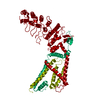

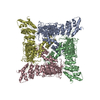
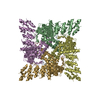
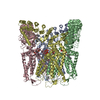
 PDBj
PDBj
